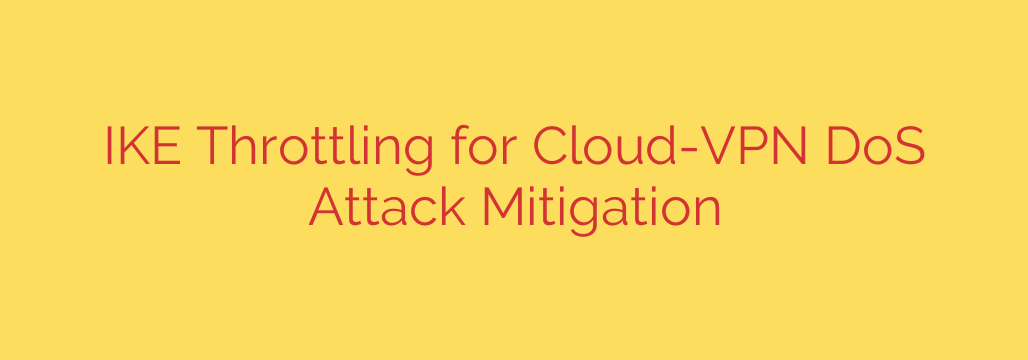
Protecting Your Cloud VPN from DoS Attacks: A Guide to IKE Throttling
Cloud VPNs are the backbone of modern hybrid networks, securely connecting your on-premises infrastructure to the cloud. This critical link ensures data flows seamlessly and securely, but its high-profile role also makes it a prime target for malicious attacks. One of the most common threats is a Denial-of-Service (DoS) attack, designed to overwhelm your VPN gateway and sever your connection to the cloud.
Fortunately, robust security mechanisms are in place to defend against these threats. One of the most effective, yet often overlooked, is IKE throttling. Understanding how this feature works is key to ensuring your network remains resilient and available.
The Anatomy of a VPN DoS Attack
To appreciate the solution, we must first understand the problem. Most Cloud VPNs use the IPsec protocol suite to create a secure tunnel, and the first step in this process is the Internet Key Exchange (IKE). During IKE negotiation, two VPN gateways authenticate each other and agree on encryption keys to build the secure tunnel.
This negotiation process, while essential, requires significant CPU and memory resources on the VPN gateway. Attackers exploit this by flooding the gateway with a massive volume of fake IKE negotiation requests. The gateway diligently tries to process every incoming request, quickly depleting its resources.
The result? The gateway becomes so busy handling bogus traffic that it can’t process legitimate requests or maintain existing connections. Legitimate VPN tunnels collapse, and your critical connection to the cloud is lost, leading to significant operational disruption.
The First Line of Defense: What is IKE Throttling?
IKE throttling is an automated defense mechanism designed specifically to mitigate these types of flood attacks. Think of it as an intelligent traffic controller for your VPN gateway. It constantly monitors the rate of incoming IKE negotiation packets.
When the rate of these packets exceeds a pre-defined, safe threshold, the throttling mechanism kicks in. It begins to selectively drop new, incoming negotiation packets. By doing this, it prevents the flood of malicious requests from ever reaching the gateway’s core processing units.
IKE throttling is a crucial, automated defense designed to maintain VPN stability during a targeted flood attack. It prioritizes the health of the gateway and the stability of existing tunnels over accepting an overwhelming number of new connection requests.
How IKE Throttling Secures Your Network
The benefits of an automated IKE throttling system are direct and substantial for any organization relying on a Cloud VPN.
Prevents Gateway Overload: The primary benefit is resource protection. By shedding excessive load, throttling ensures the gateway’s CPU and memory are preserved for its most important tasks: managing existing traffic and maintaining established tunnels. This ensures the gateway remains responsive to legitimate, established connections.
Maintains Tunnel Stability: A DoS attack’s ultimate goal is to tear down your active VPN tunnels. Because IKE throttling protects the gateway from being overwhelmed, it directly prevents this from happening. Your critical business operations can continue uninterrupted, even during an active attack.
Provides an Automated, Immediate Response: A flood attack can happen in seconds. You don’t have time for a network administrator to manually intervene. IKE throttling is an always-on, automated feature. This provides immediate mitigation without requiring any human intervention, stopping the attack in its tracks.
Actionable Security Tips for Your Cloud VPN
While IKE throttling is a powerful, built-in feature on many cloud platforms, you can enhance your security posture with these best practices:
Verify Provider Features: Not all Cloud VPN offerings are the same. When choosing a provider or reviewing your current setup, confirm that robust security features like IKE throttling are implemented by default. Check your cloud provider’s documentation to understand the specific protections they offer.
Implement Proactive Monitoring: Even if throttling is handling an attack, you need to know it’s happening. Set up monitoring and alerting for high rates of dropped packets and VPN tunnel state changes (flaps). This visibility allows you to investigate the source of an attack and take further defensive measures if necessary.
Use Strong Authentication: Throttling is one layer of defense. Combine it with strong authentication credentials for a multi-layered security strategy. Use strong, complex pre-shared keys (PSKs) or, for even greater security, move to certificate-based authentication for your VPN tunnels.
Refine Firewall Rules: Whenever possible, restrict which IP addresses can initiate IKE negotiations with your gateway. By creating firewall rules that only permit your trusted peer VPN devices, you can block a significant amount of malicious traffic before it ever reaches the gateway.
In today’s interconnected world, ensuring the uptime and stability of your Cloud VPN is non-negotiable. IKE throttling provides a silent, powerful defense that works 24/7 to protect this vital link from targeted DoS attacks, safeguarding your business continuity and network resilience.
Source: https://feedpress.me/link/23532/17113229/improving-cloud-vpn-resiliency-to-dos-attacks-with-ike-throttling








